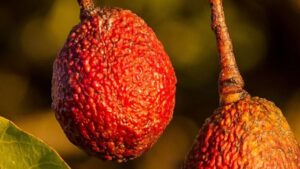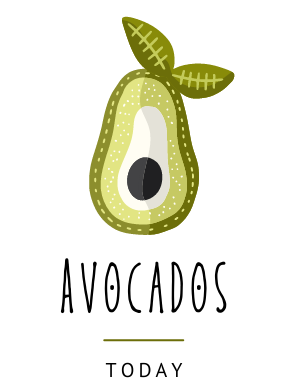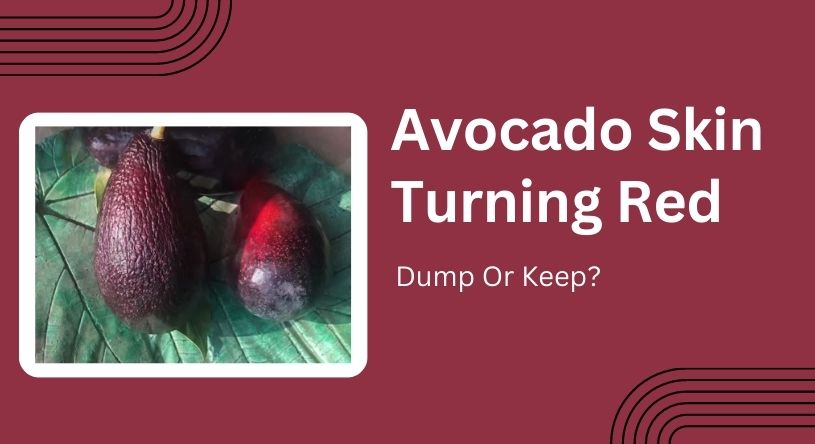From guacamole to smoothie bowls, avocados are definitely in the food spotlight right now. If you’re an avid avocado eater, you may have come across a strange blush to the peel and wondered, “Why is my avocado skin turning red?”
While we’re used to that signature green hue, reddening skin is actually natural for some varieties under certain conditions. It doesn’t mean the avocado has gone bad or changed taste. Rest assured, you can enjoy a red avocado just as much as a green one!
Let’s explore exactly why and how some avocados take on a rosy complexion. We’ll debunk myths and reveal when it’s still safe to use reddened avocados in your favorite recipes. By the end, you’ll be fully versed on this quirky quirk of everyone’s favorite superfruit.
Why Is My Avocado Red?
Avocados occasionally develop reddish skin, even before the flesh softens. This sunburn-like discoloration happens when avocados receive too much direct sunlight.
On the tree, leaves normally shade avocados from excessive sun exposure. But missing foliage in certain spots can cause sunlight to hit the bare fruit and burn the skin. This oxidation turns patches of the skin reddish or brownish.
While the skin is damaged, the interior flesh often remains unaffected and perfectly edible. However, severe sunburn can scar the fruit all the way through, compromising taste and texture. These severely sunburnt avocados have very little commercial value.

Growers themselves will often consume sunburnt avocados rather than bringing such blemished fruit to market. The damaged skin means they cannot be sold whole. At best, deeply burnt avocados can be used for guacamole, but the pay is minimal.
Home cooks may also inadvertently cause skin reddening by leaving ripe avocados out on kitchen counters in direct sun. This environmental shock can quicken oxidation and uneven ripening. The outside may become soft and red first, while the inside lags behind in ripening.
Proper storage is key. Keeping avocados shielded from light as they ripen prevents premature skin discoloration. And gently squeezing to test for yield remains the best indicator of overall ripeness.
Key points:
- Reddish discoloration is most common in Hass avocados, the variety that makes up 95% of avocados eaten in the U.S.
- As chlorophyll breaks down, anthocyanins and carotenoid pigments start to show through, causing reddish and purple hues.
- Exposure to sunlight, heat fluctuations, and dry air can accelerate this pigment change and oxidation.
- The red coloration is a cosmetic issue and does not negatively affect the flavor or nutrition of the fruit.
Avocado Turning Red After Cutting
The avocado pit contains high levels of tannins. When slicing open an avocado, direct contact between the stone and flesh can cause a harmless but unsightly red discoloration.
According to The Kitchen Chalkboard, the astringent tannins from the pit interact with iron and oxygen in the avocado flesh, forming a reddish-brown pigment. This reaction only affects the area touched by the pit.
Importantly, this tannin-induced spotting does not make the avocado pulp unsafe to eat. The reddened portion may have a slightly more bitter and oxidized taste. But the rest of the flesh should retain its normal flavor and texture.
To avoid pit stains when preparing avocados:
- Carefully slice around the pit without scraping against it.
- After removing the pit, scrape any rust-colored residue off the flesh.
- Limit metal knife exposure to prevent excess oxidation.
- Squeeze lemon juice over exposed flesh to slow browning.
With proper handling, the harmless pit-staining of avocados can be minimized. Don’t let a small red spot scare you off. Just trim affected parts and enjoy the rest guilt-free.
Avocado Turning Purple vs Red
An avocado’s signature green skin comes from chlorophyll pigments. As the fruit ripens, anthocyanin pigments like purple, red, and blue increasingly color the skin.
Sometimes these darkening skin pigments can bleed onto the flesh near the peel. It’s normal to see slight purple streaking or dark residue when opening a ripe avocado.
However, excessive purple discoloration of the interior flesh is cause for concern. This degree of unnatural coloration often indicates the avocado was damaged, dropped, or infected with fungus.
Injuries like bumps and bruises can weaken the fruit’s flesh, causing localized overripening and anthocyanin leakage. Open wounds also allow fungal infections to take hold, turning the flesh purple, black, or brown.
To avoid problematic discoloration when ripening avocados:
- Handle gently to prevent bruising.
- Store properly at room temperature.
- Watch for skin cracks that can admit fungus.
- Cut open carefully around the pit.
- Discard any oddly colored portions.
Some harmless skin-deep pigmentation is normal. But deep, extensive purple spotting inside signals an underlying issue. When in doubt, trim and play it safe
Aside From Sunburn, Can Avocados Be Red Naturally?
Yes, there are some varieties of avocados that naturally develop red-colored skin when ripe. Some examples include:

- Pinkerton – A green-skinned avocado that turns a reddish-purple when ripe. It has a smooth, creamy texture.
- Ruby – A small, plum-shaped avocado with dark red-purple skin and greenish flesh when ripe. It has a rich, nutty flavor.
- Rincon – A larger avocado with thick, dark red-black skin at maturity. The flesh is pale green with a mild, creamy taste.
- Hass – The most common variety. Some strains develop reddish spots or a reddish tinge on parts of the bumpy blackish-green skin when very ripe. The flesh remains creamy and green.
- Lamb Hass – A reddish-purple variant of Hass with rosy-blushed skin. The flavor and texture is like that of regular Hass avocados.
- Maluma – A newer variety with smooth, bright red skin when ripe and buttery yellow flesh. It’s gaining popularity for its unique look.
So while avocado skin turning red is a thing, an avocado that already has red skin is also a thing too. The red color indicates antioxidant content rather than any negative quality
Bottom Line
Avocado skin turning red can be alarming but is actually a natural part of the fruit’s ripening process. This reddening of the avocado skin happens as chlorophyll breaks down and other colorful pigments like anthocyanins build up in the later ripening stages. Environmental factors can also accelerate the harmless skin color change to red tones.
While the red skin may not be aesthetically pleasing, it does not affect the inner flesh quality or safety of eating the avocado. Focus on assessing ripeness through softness rather than outward skin shade. The red skin color alone does not indicate spoiled or bad fruit.
Properly stored and handled, an avocado can be enjoyed regardless of its exterior redness. The skin turning red is simply a sign of antioxidants accumulating, so take heart when you see those rosy hues. Rest assured the interior remains the delicious, nutritious superfood you know and love.

